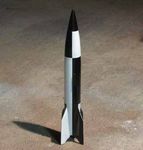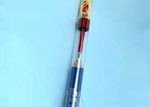How Windy is too IN THIS ISSUE - Windy for a Launch? - Apogee Rockets
←
→
Page content transcription
If your browser does not render page correctly, please read the page content below
ISSUE 498 June 25th, 2019 IN THIS ISSUE How Windy is too Windy for a Launch? www.apogeerockets.com/Rocket-Kits/Skill-Level-3-Model-Rocket-Kits/Johnny-Star-Commander
How Windy is Too Windy for a Launch?
By Ion Voss Below are a number of tools/’rules of thumb’ that one may
Introduction use where step 3 and/or step 4 is not accessible. They will
You’ve driven all the way to the launch site, probably in hopefully help you develop a sense of what should be ok and
a bit of a rush (an early start is a good start), you start set- what is definitely not safe. If you have any doubts, please
ting up and then… you notice how windy it is. To launch or seek advice from someone with experience.
not to launch – that is the question. To make an informed
decision, you need to quantify what is ‘windy’ and whether The Beaufort Scale
or not it is safe to launch. Safety is the key concern here. The Beaufort scale was developed by Francis Beaufort in
Rocketry has a very good safety record and enthusiasts an effort to quantify conditions at sea for mariners (see chart
would very much like to keep it that way. Experienced below).
modelers may find this article a bit basic but a little revi-
sion never hurts. For those who are relatively new to the
hobby, read on (and take notes!).
Simulation and Information
If you’re an enthusiastic, switched-on rocket enthu-
siast, then by the time you’re at the range you will have
already done the following;
1. Designed/built a rocket/s and dry fitted all the compo-
nents for practice.
2. Measured the CG and total mass of the finished, ready
to fly rocket and entered all the required information
accurately into a simulator.
3. Run numerous simulations allowing for (here it comes)
various wind conditions. This step will give you some
idea what to expect for a given range of conditions Figure 1: Beaufort Wind Force Scale
including how far you may have to walk to retrieve your
rocket (hopefully the dreaded cornfield is further away Seafarers in sailboats were (not surprisingly) interested
than the predicted landing zone). in whether there was enough wind to propel their vessel (1
4. Check the weather report for local conditions either the or more on the scale) or whether the sails would be ripped
night before or on the morning of the launch. apart (7 or more). For perspective, it’s interesting to note that
at 5, the use of an umbrella is a viable proposition. Around
Beginners, by now you’re hopefully gaining an ap- 6 you would need to be careful. At 7 you would leave the
preciation of how challenging the hobby of rocketry is. umbrella at home. The upper limit for 6 is 13.8 meters per
Challenging, but also very rewarding – if you do your second – remember this value. This is the speed above
‘homework’. which the effects of flowing air become significant (for us
For those who are not as ‘switched-on’ (i.e. prepared), rocket modelers at least). As a side note, for fuel economy,
there’s no need to despair. If you’re at a club launch, it’s most cars are best operated in the range of 22 m/s or less
highly likely that the more experienced modelers will be (the upper limit of 8 - about 80km/h or 50mph). Above this
able (and happy) to help you decide whether to launch speed, air resistance becomes great enough to increase fuel
or not (some models will be given a definite no if they consumption significantly.
fall outside a safe range of values, especially with more Note that wind speed is not always constant. Imagine
powerful motors – this should be seen as an opportunity a river rapid. Now stack those river rapids and have them
to improve your knowledge/skills and try again). A lot of flowing in different directions and you’re approximating what
modelers will have more than one rocket to fly – some will the air can be like in our sometimes unstable atmosphere.
be a better option on windy days. Keep those simulation Anyone who has flown in turbulence can appreciate this.
results handy. Luckily, for us modelers the air near the ground is usually
more consistent in its direction and intensity on a given day.
About this Newsletter Continued on page 3
You can subscribe to receive this e-zine FREE Newsletter Staff
at the Apogee Components website
Writer: Ion Voss
www.ApogeeComponents.com, or by clicking the link
Layout/Cover Artist: Chris Duran
here Newsletter Sign-Up
Proofreader: Michelle Mason
Page 2 Issue 498 | June 25th, 2019How Windy is Too Windy for a Launch?
Continued from page 2 lands 4m away, then the wind speed will be 2m/s and so
Also note that wind direction changes at different alti- on. If you can’t find the paper after it lands, then it’s proba-
tudes. Hot air balloon pilots exploit this to navigate to their bly best to get the anemometer out (if you’re lucky enough
chosen landing site. Obviously, this involves careful plan- to own one). The moral here is that you can estimate the
ning while consulting the latest weather information. wind speed in mild conditions with something approaching
reasonable accuracy. Which brings us to that value I men-
Estimating wind speed tioned earlier. Read on.
Estimating wind speed is relatively easy - the chart and
directions below provide one method. Note that I haven’t Minimum Velocity off the Launch Rod
verified the accuracy of this method – perhaps the reader One ‘rule of thumb’ for launching is that we want the
would like to take some measurements (in the name of rocket to have a minimum velocity of around 13.8 m/s
science, of course!). (around 30 mph) as it leaves the launch rod. The theoreti-
cal speed of the rocket can be calculated for a given rocket/
Estimating wind-speed motor combination. An option for this would be to launch off
height at point of release (m) 2 of a longer rod, if one is available. The usual approach is to
simulate again with the next more powerful motor.
time to hit ground (s) 2 Why this magic value of 13.8 m/s? Because that is the
terminal velocity (m/s) 1 speed at which the effect of the moving air becomes signif-
icant. In other words, that is the speed at which the air will
distance from point of release (m) 0 2 4
push hard enough on the fins to keep the rocket pointed in
wind velocty (m/s) 0 1 2 the direction you want it to go (which hopefully is straight up
or near to it).
Figure 2: Estimating wind-speed chart
If you take a small piece of paper (about the size of your Maximum launch mass
fingernail) and drop it, it will quickly reach terminal veloc- Manufacturers of rocket motors want us to launch safely
ity. We will use this as a gauge to measure the difference (again, safety!), so they provide us with some information
between how long the paper takes to reach the ground vs. that enables us to make informed decisions about what mo-
how far it will drift with the wind. If we drop the paper from a tors to use in what rockets. Below is a scatter plot showing
height of around 2 meters (about 6’), it should take about 2 another ‘rule of thumb’ (the 5 to 1 rule).
seconds to reach the ground. We’re not looking for decimal
accuracy here - just a count of 1 Mississippi, 2 Mississippi.
From the chart we can see that with zero wind speed, the
(lateral) distance from the point of release will be zero (no
surprises there). Now imagine the paper landing 2m away.
The falling paper will be travelling more or less at the same
lateral speed as the air in which it is falling. It will take 2s
to travel those 2m so, the wind velocity will be 1m/s. Note
that this method does not allow for ‘ground effect’. The top
of the launch rod is around 2m or less from the ground (for
Low Power launches) so this method will do. If the paper
Minimum Diameter
Motor Retainers! We Have:
Apogee is your one • Minimum Diameter
stop shop for your Retainers Figure 3: Scatter plot showing how Model Mass and Average Thrust
minimum diameter • Motor Extenders are calculated for a safe launch.
rockets projects! • Threaded Forward Continued on page 4
• Fly High
Closures
• Fly Fast
• Adapters for
• Impress Your Friends!
Cesaroni Cases
www.ApogeeRockets.com/Building_Supplies/Motor_Retainers_Hooks
Page 3 Issue 498 | June 25th, 2019How Windy is Too Windy for a Launch?
Continued from page 3 is a link to this at the end of this article.) One of the as-
It’s interesting to note that for the respective rocket/mo- sumptions of this method is that the angle of attack is less
tor combinations, at their maximum recommended mass, than 10 deg. Why less than ten degrees? Because as the
some of them fail the 5 to 1 rule. Without an accurate sim- angle of attack increases, the center of pressure moves
ulation to go by, we might think that it’s not safe to launch forward which reduces our static margin and could poten-
those combinations. In reality, the initial thrust of the tially turn our nicely made (but now unstable) rocket into
motor is much greater and so a heavier rocket may still be a “lawn dart”. It is worth viewing this information purely to
launched safely provided it does not exceed the maximum be aware of the assumptions that ensure the accuracy of
mass as recommended by the manufacturer. With accu- this method. If your rocket’s attributes violate any of these
rate simulations, the ‘5 to 1’ rule becomes redundant. assumptions then caution is advised. Again, with a simula-
If you don’t have access to a simulator, then to err on tor, manual calculations of this nature are not required and
the side of safety, so the weight of the finished rocket simulation results may be relied on.
would need to be less than the specified maximum. It
would then fall to the left of the go/no go boundary. Note
that Figure 3 does not tell us anything about the optimum
delay period. For that you need either some experience
and/or simulated results. As yet, we haven’t considered
what effect the wind will have on our launch.
Angle of attack
Normally, when we talk about angle of attack, we’re
imagining the rocket in flight. As the rocket oscillates,
the angle of attack (and the air pressure on the fins) is
increasing and decreasing repeatedly while the rocket
maintains a stable flight. (The magnitude and frequency
of that oscillation is determined by many factors and is
referred to as dynamic stability. There are other articles
that cover this subject far better than I can – see the end
of this article for references.) For this article, imagine that
the rocket is stationary on the launch rod. Any wind that is
blowing will be at 90 deg. to the fins. (This 90 deg. angle
of attack isn’t relevant because the rocket is held straight
by the launch rod.) Now imagine the same rocket leaving
the launch rod at our magic figure of 13.8 m/s. That same Figure 4: The A4 (or V2 as it came to be known) violates more than
wind will now (hopefully) have a much lower velocity rel- one of the assumptions for the Barrowman method of calculating the
ative to the speed of the rocket. When we compare these centre of pressure. This model is right on the maximum weight for
speeds and break them down into vector components, we a D12-5. It has a static margin of 0.6 and has a lot of nose weight
can use trigonometry to calculate the angle of attack. to achieve that. Definitely not one to launch on a windy day. No pics
Note: Jim Barrowman kindly gave us a very nice of this one in flight but I recall seeing it oscillating noticeably in light
method to calculate a rocket’s center of pressure. (There winds.
Continued on page 5
www.apogeerockets.com/Electronics-Payloads/Rocket-Locators/Simple-GPS-Tracker
Page 4 Issue 498 | June 25th, 2019How Windy is Too Windy for a Launch?
Continued from page 4 peak altitude would obviously be reduced. Remember
For rockets where the static margin is approaching the that at a wind speed of 4.5 m/s, our dropped piece of
minimum, wind, or the lack of it becomes a critical factor in paper would drift about 9 meters.)
deciding whether or not to proceed with a launch. As you’ll 3. With a model of around 0.085kg (the limit for an A8-3),
see on the chart below, it’s possible to have an angle of at- to maintain the same limits for AOA, the allowable wind
tack that is greater than ten degrees at the moment that the speeds are reduced.
rocket leaves the launch rod. All it takes is a gust of wind of
sufficient magnitude.
To rationalize what we’ve looked at so far, I’ve cooked
up a chart which will hopefully give you some food for
thought (pun intended). The actual values may be slightly
off (depending on the method used to calculate this very
dynamic event) but of more interest is the comparison of
values for the rocket/motor combinations and the resulting
speed of the rocket at a given height vs. the prevailing wind
conditions.
The Nitty Gritty
The speed of a rocket may be calculated for the moment
that it leaves the launch rod (for a 1 meter launch rod, the
rocket will have traveled about 900mm because the launch
lug is already higher than the bottom of the rod). At the
moment that the rocket leaves the rod, it will have a certain
Figure 5: A chart created to compare the calculations of the degree of
angle of attack (AOA) which is relative to the speed of the
the angle of attack, the mass of the rocket, and the wind speed.
rocket and a given wind speed. Obviously, a heavier rocket
will have less acceleration and less speed when it leaves Keep in mind that just because the chart says a launch
the launch rod. All of the derived values below assume the lies outside a given range, the actual launch may be safe
use of an A8 single use motor (neglecting the delay period). in that the rocket may (optimistically) experience a brief
Please refer to the chart and see the numbered examples moment where it pitches, regains a stable attitude and
below; continues its flight (if it doesn’t rip the fins off – now we start
1. If we limit the AOA to 10 degrees or less, and we launch thinking about structural integrity and fillets). On the other
a rocket of mass 0.035kg, the wind speed would need hand, if it pitches and fails to regain a stable attitude (we call
to be 3 m/s or less. (You may think this is a very light this sky-writing – it’s what your E.C.G. might look like if they
rocket. It is an extreme example but it is achievable.) could capture it while you watch your expensive hardware
2. With the same rocket, leaving the launch rod at the pitching violently) it will crash. Possibly damaging someone
same speed, if we increase the wind speed to 4.5 m/s, or some thing in the process. What we’re concerned with
our AOA would be approaching 15 degrees. (In practice, here is the more extreme combinations – short launch rod,
it’s likely the rocket would pitch slightly at the end of the heavy rocket, narrow static margin, gusty winds (would you
launch rod. The AOA would immediately be reduced. be comfortable using an umbrella?), any or all of the above.
The rocket would still be accelerating so provided it Educate yourself and use discretion. All jokes aside, safety
regains a stable attitude, the flight would continue – the is no joke. Be safe.
Continued on page 6
www.apogeerockets.com/Rocket-Kits/Skill-Level-2-Model-Rocket-Kits/SkyMetra
Page 5 Issue 498 | June 25th, 2019How Windy is Too Windy for a Launch?
Continued from page 5
With regard to ‘weather-cocking’, this is not always a
bad thing as the rocket that weather-cocks up-range will
result in less walking down-range for retrieval. So, having a
static margin of at least 2 (3 to 4 is possibly a bit of over-
kill?) starts to look like an attractive proposition for a more
launch friendly rocket. It also allows some margin for error
and reduces uncertainty on the more windy days. The
worst-case scenario here (assuming a stable flight) is wind
(and weather-cocking) at launch followed by opposite wind
at deployment (and a very long walk). Timing becomes an
issue when there is instability in the weather and it is very
much a lottery where the rocket will land.
References
https://www.apogeerockets.com/downloads/PDFs/
barrowman_report.pdf
Figure 7: This rocket – the Estes Astron Sprint XL (junior rocket
modeler provided for scale) satisfies all of the assumptions for the
Barrowman method for calculating the centre of pressure (except for
the rounded edges on the fins). Note the CP mark (black dot) – this
helps alleviate the Range Safety Officers’ stress levels. On its maiden
flight, this rocket flew to 987’ on a D12-7 in calm weather.
Figure 6: Even after making an informed decision on whether to launch,
there are still mishaps that can throw you off your game. If you look
closely, you’ll notice that three of the six motors in this cluster didn’t
ignite. This rocket was poorly designed and didn’t fare well during
deployment – but that is another story.
Figure 8: Ian Voss
About the author
Ian Voss lives in Queensland, Australia and hopes to
achieve his L1 certification “one day”. Although he is not
currently a member of the Queensland Rocketry Society, he
looks forward to returning when his work/life balance allows
it. Ian firmly believes in the benefits of getting involved in
the hobby of model rocketry. “As a tool to promote learning,
rocketry is hard to beat. It’s exciting and fun and captures
www.ApogeeRockets.com/RockSim/RockSim_Information
the imagination like few other things can.”
Page 6 Issue 498 | June 25th, 2019You can also read



























































